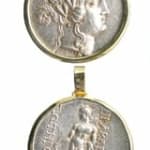Gold Pendant with Silver Tetradrachm from the Island of Thasos, 2 Century BCE - 1st Century BCE
Silver and Gold
FJ.6919
Further images
Thasos is an island in the north Aegean Sea, off the coast of Thrace, which contained prolific gold mines during ancient times. Archilochus described Thasos as ' an ass's backbone...
Thasos is an island in the north Aegean Sea, off the coast of Thrace, which contained prolific gold mines during ancient times. Archilochus described Thasos as " an ass's backbone crowned with wild wood," and the description still suits the mountainous island with its forests of fir. Besides its gold mines, the wine, nuts and marble of Thasos were well known in antiquity. The island was colonized at an early date by Phoenicians, probably attracted by its mines Thasus, son of Phoenix, is said to have been the leader of the Phoenicians, and to have given his name to the island. During the 7th Century, the island became increasingly Hellenized, through contact with the Greeks who began settling along the coastal regions of Thrace. Thasos also enjoyed controlling interest in several silver mines on the Greek mainland, a testament to the enormous wealth and power of this island. In 492 BC, Thasos fell to the Persians during the Ionian revolt. After the defeat of Persia by Athens, Thasos joined the Delian League. Later, the island would come under Roman control. Today, the gold mines and marble quarries have all been depleted. However, this silver tetradrachm is a stunning memorial to the golden age of this ancient island.
The splendor of the precious metals is allowed to shine in this pendant. The natural hues of the silver and gold complement each other. In this pendant, the present and the past combine. The classical form of the modern pendant enhances the timeless beauty and majesty of the ancient coin. To wear this pendant is to reconnect with the past while continuing to look stylish in the present.
The splendor of the precious metals is allowed to shine in this pendant. The natural hues of the silver and gold complement each other. In this pendant, the present and the past combine. The classical form of the modern pendant enhances the timeless beauty and majesty of the ancient coin. To wear this pendant is to reconnect with the past while continuing to look stylish in the present.





